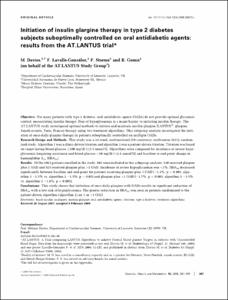KUMEL Repository
1. Journal Papers (연구논문)
1. School of Medicine (의과대학)
Dept. of Internal Medicine (내과학)
Initiation of insulin glargine therapy in type 2 diabetes subjects suboptimally controlled on oral antidiabetic agents: results from the AT.LANTUS trial
- Keimyung Author(s)
- Kim, Hye Soon
- Department
- Dept. of Internal Medicine (내과학)
- Journal Title
- Diabetes, Obesity and Metabolism
- Issued Date
- 2008
- Volume
- 10
- Issue
- 5
- Abstract
- Objective: For many patients with type 2 diabetes, oral antidiabetic agents (OADs) do not provide optimal glycaemic
control, necessitating insulin therapy. Fear of hypoglycaemia is a major barrier to initiating insulin therapy. The
AT.LANTUS study investigated optimal methods to initiate and maintain insulin glargine (LANTUS
Ò
, glargine,
Sanofi-aventis, Paris, France) therapy using two treatment algorithms. This subgroup analysis investigated the initi-
ation of once-daily glargine therapy in patients suboptimally controlled on multiple OADs.
Research Design and Methods: This study was a 24-week, multinational (59 countries), multicenter (611), random-
ized study. Algorithm 1 was a clinic-driven titration and algorithm 2 was a patient-driven titration. Titration was based
on target fasting blood glucose 100 mg/dl ( 5.5 mmol/l). Algorithms were compared for incidence of severe hypo-
glycaemia [requiring assistance and blood glucose <50 mg/dl (<2.8 mmol/l)] and baseline to end-point change in
haemoglobin A
1c
(HbA
1c
).
Results: Of the 4961 patients enrolled in the study, 865 were included in this subgroup analysis: 340 received glargine
plus 1 OAD and 525 received glargine plus >1 OAD. Incidence of severe hypoglycaemia was <1%. HbA
1c
decreased
significantly between baseline and end-point for patients receiving glargine plus 1 OAD (1.4%, p < 0.001; algo-
rithm 1 1.3% vs. algorithm 2 1.5%; p ¼ 0.03) and glargine plus >1 OAD (1.7%, p < 0.001; algorithm 1 1.5%
vs. algorithm 2 1.8%; p ¼ 0.001).
Conclusions: This study shows that initiation of once-daily glargine with OADs results in significant reduction of
HbA
1c
with a low risk of hypoglycaemia. The greater reduction in HbA
1c
was seen in patients randomized to the
patient-driven algorithm (algorithm 2) on 1 or >1 OAD.
Keywords: basal insulin analogues, insulin glargine, oral antidiabetic agents, titration, type 2 diabetes, treatment algorithms
Received 20 August 2007; accepted 8 February 2008
- Keimyung Author(s)(Kor)
- 김혜순
- Publisher
- School of Medicine
- Citation
- M. Davies et al. (2008). Initiation of insulin glargine therapy in type 2 diabetes
subjects suboptimally controlled on oral antidiabetic agents:
results from the AT.LANTUS trial. Diabetes, Obesity and Metabolism, 10(5), 387–399. doi: 10.1111/j.1463-1326.2008.00873.x
- Type
- Article
- ISSN
- 1462-8902
- Appears in Collections:
- 1. School of Medicine (의과대학) > Dept. of Internal Medicine (내과학)
- 파일 목록
-
-
Download
 oak-aaa-01630.pdf
기타 데이터 / 222.03 kB / Adobe PDF
oak-aaa-01630.pdf
기타 데이터 / 222.03 kB / Adobe PDF
-
Items in Repository are protected by copyright, with all rights reserved, unless otherwise indicated.